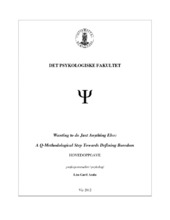| dc.description.abstract | Boredom is a commonly reported phenomenon with apparent ecological validity which remains under-researched and poorly defined by academic literature. This study used Q methodology in moving towards a unifying conceptual understanding of how people perceive boredom, thereby improving the foundation for further research and for the creation of valid measuring instruments for both state and trait boredom. The sample consisted of 10 Norwegian students (aged 19-26) and 10 seniors (aged 61-89). All completed a 40-statement Q-sort task, with data subjected to an inverse factor analysis using the PQMethod computer software. Results identified three factors to the students' perception of boredom: Active boredom, boredom coping, and passified boredom, with aspects of restlessness and disengagement from a current task common to all factors. Elderly people appeared to be markedly less prone to boredom than were students, and possible reasons for this are also discussed. | en_US |
